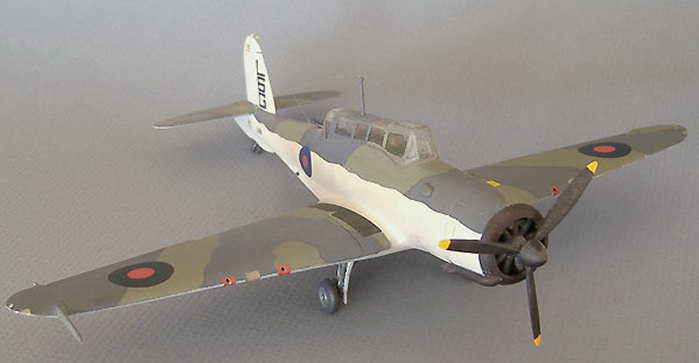
Frog 1/72 Blackburn Skua II
| KIT: | Frog 1/72 Blackburn Skua II |
| KIT #: | F-162 |
| PRICE: | $ |
| DECALS: | ? |
| REVIEWER: | Kim Elliott |
| NOTES: |

| HISTORY |
The Blackburn Skua was the
first operational monoplane in the British Fleet Air Arm, also the first
designed specifically for the dive bombing role. Replacing the Hawker Osprey and
Nimrod, the aircraft entered service in 1938. It was on strength of 800,
801,803, 806 Sqd., as well as numerous second line squadrons. Armed with four
Browning .303s in the wings, plus a rearward
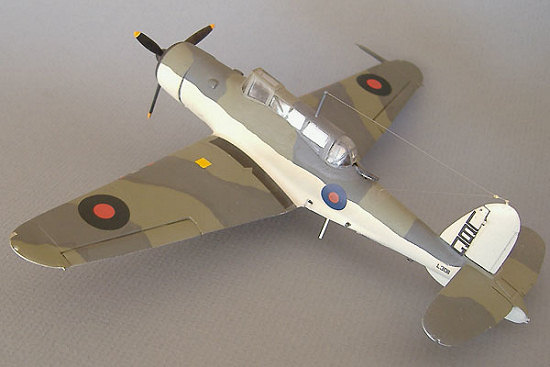 firing Lewis in the observer’s
cockpit, it could act as a fleet fighter. On 25th September 1939, a
Skua of 803 Sqd. destroyed a Do 18 off Heligoland-the first F.A.A. kill of the
war. Skuas saw active service in Norway, sinking the cruiser Konigsberg
during 1940. Later in the same year, aircraft from 800 Sqd. bombed the
Richelieu at Dakar. During the Dunkirk evacuation, 801 Sqd., attached to
Coastal Command, flew the Skua in both fighter and bomber roles off the French
Channel coast. Later, Mediterranean ops saw the Skua used successfully as a
fighter against Italian aircraft, and unsuccessfully as a dive bomber against
Italian ships. A strike against the Scharnhorst and Gneisenau in
Brest harbour during the summer of 1941 was cancelled, after protracted
planning, and with it ended the Royal Navy’s front line use of the Skua.
Remaining aircraft served for several years as target tugs and advanced
trainers in second line units.
firing Lewis in the observer’s
cockpit, it could act as a fleet fighter. On 25th September 1939, a
Skua of 803 Sqd. destroyed a Do 18 off Heligoland-the first F.A.A. kill of the
war. Skuas saw active service in Norway, sinking the cruiser Konigsberg
during 1940. Later in the same year, aircraft from 800 Sqd. bombed the
Richelieu at Dakar. During the Dunkirk evacuation, 801 Sqd., attached to
Coastal Command, flew the Skua in both fighter and bomber roles off the French
Channel coast. Later, Mediterranean ops saw the Skua used successfully as a
fighter against Italian aircraft, and unsuccessfully as a dive bomber against
Italian ships. A strike against the Scharnhorst and Gneisenau in
Brest harbour during the summer of 1941 was cancelled, after protracted
planning, and with it ended the Royal Navy’s front line use of the Skua.
Remaining aircraft served for several years as target tugs and advanced
trainers in second line units.
As a dive-bomber, the Skua carried a 500lb bomb semi-recessed under the fuselage, maintaining propeller clearance with swinging release arms. Eight 30lb. bombs could be carried beneath the wing on light series carriers. It was powered by a Bristol Perseus XII of 890 h.p., and had a maximum gross of 8240 lb.. Maximum speed was 225 mph at 6,700 ft., and range was 720 miles. Maximum climb rate was 930 ft./min. at 6000ft.. Although modest by later standards, these figures compared favourably with contemporaneous models designed for a similar role, such as the Stuka, Aichi Val, SBD, or SB2U.
| THE KIT |
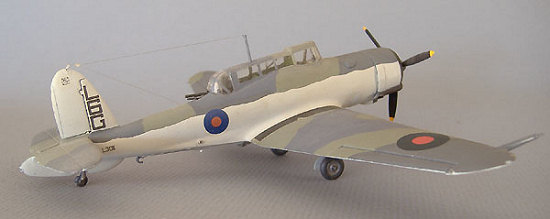 Frog released an injection moulded
kit in the mid ‘60s, F.162, Red Series, to 1/72 scale that was
subsequently re-packaged by Novo. The same mouldings have been
re-released by several East European concerns (Chematic, Eastern Express,
et al), and Revell now own the rights. The 1997 release by Revell
was eagerly awaited, but they failed to make any changes to the original mould
save delete the clear stand. New box art, decals and price serve to distinguish
it from the earlier versions.
Frog released an injection moulded
kit in the mid ‘60s, F.162, Red Series, to 1/72 scale that was
subsequently re-packaged by Novo. The same mouldings have been
re-released by several East European concerns (Chematic, Eastern Express,
et al), and Revell now own the rights. The 1997 release by Revell
was eagerly awaited, but they failed to make any changes to the original mould
save delete the clear stand. New box art, decals and price serve to distinguish
it from the earlier versions.
The
Frog/Novo/Revell kit of the Skua is vintage 1960’s construction: 38 parts
in grey plastic, 2 clear. The control surfaces are separate, the engine is a
distinct component, and the u/c comprises 4 parts for each main leg. Detail
under the clear canopy glazing is meagre, consisting of a floor, 2 basic seats,
and a crude Lewis gun. Panel lines are raised. Cowl flaps are represented in the
open position, but need thinning. Missing are the hook, bomb crutch, bomb, wing
racks, and pitot. Decals consist of national markings and a serial number in the
Frog release; the Novo markings are unusable; Revell decals
are for 759 NAS and 806 NAS. Reference to drawings shows basic dimensions as
correct, although serious discrepancies are to be found with the horizontal tail
surfaces, ailerons and wing chord. The fuselage wing root fairings and ventral
fin appear to be slightly undersize, although in 1/72 this may be overly
critical. On the underside, there is no bomb recess or fairing.
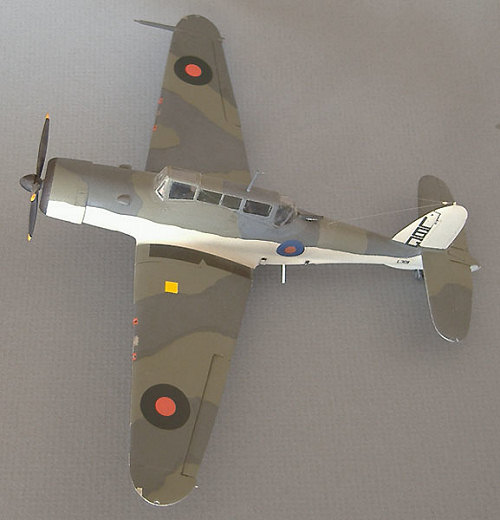
One may build a Skua model as moulded with relative ease, or correct the most egregious errors with some difficulty and cost, the wing and stabilizer chord being the most demanding. There have been a couple of resin offerings to aid the modeller: Magna Models produce a conversion kit with resin wings, tailplane, vac. canopy and landing lights. Final Touch Products made a conversion kit, with resin wings, tailplane, and canopy. Airwaves have a photo-etch detailing set. Included in a Falcon Fleet Air Arm canopy selection is a corrected canopy. Aeroclub and others have resin Perseus engines.
| CONSTRUCTION |
Before any of the aftermarket parts were available, I built the Frog kit, addressing the tail and wing chord. This was done with reference to published drawings, using sheet plastic cut and sanded to shape for the stabilizers. The wings were a little more complex. The chord was established with a leading edge extension made from sheet plastic, then filled with Milliput epoxy putty to achieve an aerofoil shape. This was aligned with the kit l/e location - the trailing edge root being extended with sheet plastic and putty. All panel lines were removed. The canopy was replaced at a later stage with a vacu-formed unit, being as supplied quite inaccurate. Detailing extended to the exhaust, made of brass tubing; cowl flaps removed and replaced with scribed plastic strip; scratch built arrester hook, bomb crutch, ventral fairing, pitot, and accelerator (catapault) points. A half bomb was attached to the underside, in the recessed position. No attempt was made to hollow out the bomb recess, or replace/detail the engine. The undercarriage was assembled and installed per instructions, taking care to get the correct angle of the legs to the datum. The wells are not boxed in, being quite intricate.
| COLORS & MARKINGS |
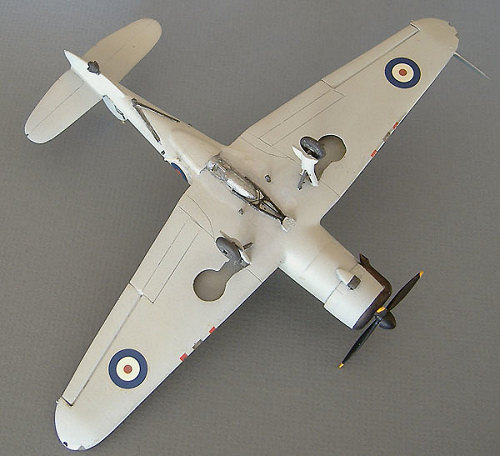 Painting
was done using gloss Xtracolor enamels. This was the first time use I had used
them. The Extra Dark Sea Grey and Dark Slate Grey seem to be light - rather like
Dark Sea Grey and Light Slate Grey to my eye. No Sky Grey being available, a
mix was made from black and white paint. Cowling ring and exhaust was in
darkened copper, and the cockpit in RAF Interior Green. The entire model
(excepting clear canopy and landing light) was sprayed with Testors Dull Coat
lacquer, after decal application. Invisible mending thread became the radio
antennae wire. The markings were improvised to represent an 806 NAS aircraft
over Dunkirk in 1940. It may have had the black/white recognition scheme under
the wings. Revell have included these markings on their decal sheet, but
incorrectly identified it.
Painting
was done using gloss Xtracolor enamels. This was the first time use I had used
them. The Extra Dark Sea Grey and Dark Slate Grey seem to be light - rather like
Dark Sea Grey and Light Slate Grey to my eye. No Sky Grey being available, a
mix was made from black and white paint. Cowling ring and exhaust was in
darkened copper, and the cockpit in RAF Interior Green. The entire model
(excepting clear canopy and landing light) was sprayed with Testors Dull Coat
lacquer, after decal application. Invisible mending thread became the radio
antennae wire. The markings were improvised to represent an 806 NAS aircraft
over Dunkirk in 1940. It may have had the black/white recognition scheme under
the wings. Revell have included these markings on their decal sheet, but
incorrectly identified it.
| CONCLUSIONS |
In conclusion, the model required rather more work to make accurate than I am comfortable with today with existing references. It was another story when it was first issued, being the only choice. Although it may still be found in Revell and Eastern Express boxings, I would recommend the Pavla/Octopus or MPM/Special Hobby version of this aircraft model to prospective builders.
| REFERENCES |
http://freespace.virgin.net/john.dell/blackburn_skua.htm
Brown, E.: Wings of the Navy
Jackson, A. J.: Blackburn Aircraft since 1909
Peter C. Smith: Skua! The Royal Navy’s Dive-Bomber
Kim Elliott
2007
Copyright ModelingMadness.com. All rights reserved. No reproduction in any form without express permission from the editor.
If you would like your product reviewed fairly and quickly, please contact the editor or see other details in the Note to Contributors.